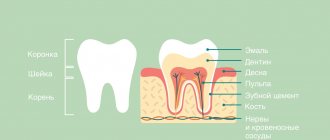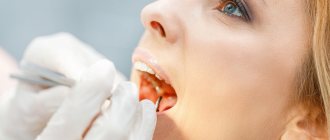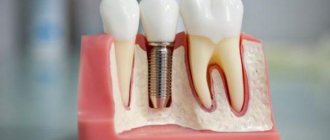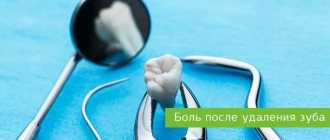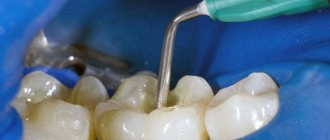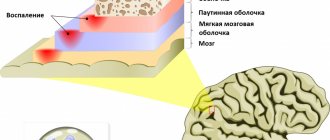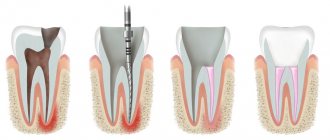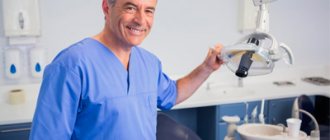This state cannot be called merely unpleasant or uncomfortable. Pulsating pain in a tooth can not only reduce a person’s quality of life - because of it, he may temporarily lose the ability to work normally, sleep, eat, etc. Dentists at the CrystalDent clinic urge all patients who are faced with this problem not to endure this condition in the expectation that it will go away on its own. The specialist strongly recommends immediately seeking help from a doctor and talks about the nature, causes, and methods of dealing with this problem.
Tooth hurts when walking
Pain in a tooth (dentalgia) can be a constant ache, occur suddenly, or intensify while walking and running. In the first case, we are talking about the development of inflammatory or non-carious lesions in the oral cavity. When there are no unpleasant sensations at rest, but appear suddenly while walking or running, this indicates a hidden course of the chronic process in the periodontal tissues.
When dentalgia intensifies during movement, this also indicates an acute or chronic inflammatory process of the pulp or periodontal tissue. Such manifestations of pain are characteristic of various diseases of the oral cavity and nearby organs.
Important! To choose the right treatment option, you should identify the underlying cause of tooth pain when walking, jumping and running.
Tooth and temple pain: causes and treatment
Toothache often does not visit us alone, but is accompanied by pain in the jaws, temples, eyes, head and neck. If you have a toothache or temple pain, then this is a reason to immediately consult a doctor.
Tooth and temple pain: the most common causes
Toothache comes in many forms and shades. Based on the sensations the patient experiences, we can draw preliminary conclusions about his disease.
- If your teeth start to hurt from eating cold, hot, overly sweet or spicy food, from inhaling cold air, or from squeezing your jaw too hard, you most likely have hypersensitive tooth enamel or early stage caries.
- If pain occurs periodically and is not associated with any external irritants, you most likely have pulpitis.
- If the pain is constant, severe, throbbing, then we are talking about periodontitis.
If both the tooth and the temple hurt, we can conclude that the disease has already entered the pathological stage. This means that a visit to the dentist can no longer be put off, because we are talking not just about the health of your teeth, but also about preserving them in principle.
But toothache radiating to the temple is not always pathological.
A fairly common case is the eruption of the eighth molars, or, more simply, wisdom teeth. Few of us experience the growth of wisdom teeth easily and painlessly. When the eighth molar erupts, inflammation of the surrounding soft tissues often occurs, which can spread to the lymph nodes and muscles. In this case, only a dentist can alleviate your suffering.
Tooth and temple pain: how to reduce pain at home
As you understand, only a competent dentist can detect the source of the disease and cure it. All you have to do is try to reduce the pain while waiting for your appointment. At night, you can take an analgesic or antispasmodic tablet. It is best to put it on the sore tooth and chew it. If you are a supporter of traditional methods, try rinsing and bathing with a decoction of sage, chamomile, or soda or hydrogen peroxide. You can put a cotton swab soaked in clove oil on the sore tooth. Whatever you choose from the methods listed above, remember that only a doctor can eliminate the cause of acute pain radiating to the temple.
You can get a consultation at the DENTISTRY clinic. Make an appointment by calling +7 (8342) 308–088 or using the form below.
Make an appointment
Why do my teeth hurt when I walk?
The appearance of dentalgia when walking can be associated with purulent inflammation directly in the oral cavity or in the maxillary sinus.
The cause of unpleasant sensations can be localized in the upper or lower jaw, dental pulp, or periodontal tissues. To determine the etiology, it is necessary to take an x-ray.
Photo 1: Throbbing pain, which intensifies during movement, very often indicates the accumulation of purulent exudate in the periodontal tissues. In an attempt to find a way out, it compresses the tissue, which causes throbbing pain and it always intensifies while walking with each hit of the heel. Source: flickr (Anton Pro).
Possible causes of dentalgia when walking
- Periodontal tissue disease . These are periodontitis, abscess, phlegmon, pericoronitis, periodontitis, granuloma, cyst, periostitis.
- Diseases of hard and soft dental tissues . This is medium and deep caries, purulent or acute pulpitis.
- Disease of nearby tissues . This is odontogenic, traumatic, bacterial, allergic sinusitis.
Dental causes of pain when running and jumping
When running, the feet come into contact with a hard surface as often as possible, but this happens in such a way that the shock absorption does not allow injury to the limbs or other organs . If a person landed on his heels while jumping or running, this would have unpleasant consequences, and a concussion is the most harmless.
shock absorption while walking or running, .
The slightest movement, not to mention jumping, in case of inflammation of the nerve causes severe pain . Caries or periodontal inflammation respond to movement less painfully, but still unpleasantly.
Diseases that cause tooth pain when running and jumping
- Medium or deep caries is the destruction of hard tooth tissues when they are not treated in a timely manner; the carious process comes too close to the pulp, which reacts to the irritant, which gives rise to dentalgia.
- Pulpitis is an inflammation of the nerve of the tooth, among all dental diseases it ranks first in terms of severity of pain; in case of complications, pus accumulates in the chamber, a chronic process begins and dentalgia gradually subsides, but can again appear while running.
- Periodontitis and periodontitis - these inflammatory diseases very often become a chronic process, since at an early stage they give little expressed pain, a person endures without consulting a doctor, but at this time the inflammation only progresses, the discomfort goes away, but when exposed to any irritant, including I hit my foot while running and the pain comes back immediately.
- Less common causes of pain when running and jumping are granuloma and cyst . These are complications of untreated periodontitis, which initially does not cause concern due to its moderate pain and the person does not go to the dentist. In this case, granulation gradually destroys the soft tissue around the tooth and a so-called granulation sac is formed around it. As with a cyst, this sac puts pressure on the tissue, causing pain.
Accompanying illnesses
In addition to the listed dental diseases, the cause of discomfort while walking, running or jumping can be pathological processes in the maxillary sinus. In this case, pain will be felt in the upper jaw area near the molars . This symptom is very easy to confuse with dentalgia, so other typical manifestations of sinusitis should be considered.
Pain at the base of the skull
Rheumatism
Arthritis
33393 11 February
IMPORTANT!
The information in this section cannot be used for self-diagnosis and self-treatment.
In case of pain or other exacerbation of the disease, diagnostic tests should be prescribed only by the attending physician. To make a diagnosis and properly prescribe treatment, you should contact your doctor. Pain at the base of the skull: causes of occurrence, what diseases it occurs with, diagnosis and treatment methods.
Definition
Pain at the base of the skull (vertebrogenic cervicocranialgia) is a pain syndrome localized in the cervico-occipital region, which can spread to the frontotemporal region and the eye area on the homolateral side. It has been proven that the source of pain can be the structures of the upper cervical spine. Typically, this is the level of the C1, C2 and C3 vertebrae, which includes joints, discs, ligaments and muscles. The lower cervical vertebrae, as a rule, play an indirect role in the formation of clinical symptoms of pain.
Pathological diseases of the cervical spine, which are accompanied by intense or aching pain, experts call “painful neck” syndrome.
The International Headache Society, 3rd revision (ICHD-3) recommended considering cervicogenic headache as secondary, arising due to changes in the cervical spine, including bone structures, intervertebral discs, and soft tissue structures, the pathology of which is often accompanied by pain in the cervical spine. neck. 70% of patients with pain in the cervical spine simultaneously experience headache, but only in 18% of cases is it considered a consequence of neck pain.
In the genesis of headaches in childhood and adolescence, functional disorders in the spinal motion segments of the cervical spine, in particular disorders in the structures of its upper cervical spine, play a significant role.
Types of pain at the base of the skull
Cervicogenic pain is indicated by differential features such as unilateral headache extending from the back of the head to the front, and evidence of involvement of the cervical spine. An attack of pain can be triggered by applying pressure to trigger points in the neck/occipital area or holding the neck in an awkward position. It is important that in some cases such pain has migraine-like features - a number of patients experience photo- and phonophobia, lacrimation, nausea, vomiting, which can sometimes be regarded as a manifestation of migraine.
Pain at the base of the skull is characterized by limited range of motion in the cervical spine, soreness of the neck muscles, changes in muscle tone, or a reaction to passive or active stretching. Usually the pain is combined with a functional block at the upper cervical level.
Injuries to the upper cervical spine due to tumors, fractures, infections, and rheumatoid arthritis can cause headaches that present clinically in the same way as cervicocranialgia. However, a feature of cervicogenic headache is that it is provoked by movements in the cervical spine, and after performing certain warm-up movements in the neck it can stop. Most often, such complaints are not associated with serious pathology, and the patient makes a full recovery.
Possible causes of pain at the base of the skull
Pain at the base of the skull is based on functional and organic changes in various anatomical structures of the cervical spine: joints, ligaments, fascia, muscles, nerves. The leading role is given to degenerative-dystrophic changes in the spine. However, there are only isolated indications of the role of functional disorders.
One of the main causes of neck pain is staying in a fixed position for a long time. Other causes of the disease include:
- osteochondrosis, spondyloarthrosis, spondylosis, uncovertebral arthrosis and other changes in the spine;
- neck injuries, injuries;
- sprains;
- intervertebral disc herniation;
- spondyloarthritis, rheumatoid arthritis.
A common cause of cervicogenic pain is inferior oblique muscle syndrome.
A spasmed muscle can compress the neurovascular bundle passing under it (segment of the vertebral artery with the periarterial sympathetic plexus, occipital nerves) - for this condition, the development of paresthesia in the scalp is typical, and sometimes there is pain when combing the hair. It has been observed that stimulation of the cervical structures causes pain, and anesthesia reduces it. Lately, doctors are increasingly talking about “text neck” syndrome, which develops in people who spend a lot of time reading texts from electronic devices (gadgets).
The head of an adult weighs about 5 kg - this is the weight the neck experiences in its normal position. When reading from gadget screens, the head is usually tilted: when tilted just 15°, the load on the spine increases to 12 kg, and when tilted 60° – up to 27 kg. As a result, posture changes, the intervertebral discs of the cervical spine suffer, muscles spasm, and pain occurs at the base of the skull.
The main manifestations of pain at the base of the skull include:
- frequent contraction of the neck muscles, convulsions;
- painful sensations when turning the head;
- noise in the head, sleep disturbance;
- pain in the cervical spine, radiating to the head;
- dizziness;
- constant tension in the neck and back of the head.
The presence of three to four signs should make the patient think about seeking medical help.
Which doctors should you contact if you experience pain at the base of the skull?
To determine the cause of the headache, you should contact a general practitioner or. The doctor will prescribe the necessary examination, determine the cause of the disease and prescribe treatment.
Diagnosis and examinations for pain at the base of the skull
The following diagnostic criteria are used to make a diagnosis:
- The causal relationship of headache with pathology of the cervical region is based on at least one of the following signs:
- clinical signs confirm that the source of pain is located in the neck;
- pain stops after diagnostic blockade of neck structures or nerve formations (with an adequate comparative study with placebo).
Using clinical, laboratory and/or neuroimaging methods, signs of disorder or damage in the cervical spine or soft tissues of the neck that are a reliable or possible cause of headache are determined:
- X-ray of the cervical region in several projections;
What you can do yourself
If a toothache suddenly appears, you should:
- apply a cold compress to the cheek on the sore side; heat treatment is contraindicated, as this increases blood circulation and leads to the spread of infection;
- examine your teeth, identify possible food debris, remove them and rinse your mouth with a warm solution and soda;
- take a pain reliever (Ketanov, Diclofenac, Solpadeine);
- Visit your dentist as soon as possible for an x-ray.
Note! Dentists recommend using Nimesil powder to quickly relieve pain.
Photo 2: After a dental examination, the doctor will carry out professional hygiene and sanitation of the oral cavity, after which the dentist will prescribe medications. Source: flickr (Aviel Stankevitch).
Causes of tooth pain when walking
If dentalgia occurs while moving, most likely the disease is already advanced. You need to see a doctor, take a photo and treat the damaged tooth. Pain is not always observed when a hole appears. Discomfort felt:
- with inflammation of the gums;
- after unsuccessful intervention;
- due to pathologies of other organs;
- with advanced caries.
Dentalgia is present with periodontal damage, the formation of pus in the maxillary sinuses and in soft tissues. Throbbing pain occurs when a phlegmon, granuloma or cyst forms. It is localized in the tooth cavity, in the jaw.
A pathological sensation accompanies periodontitis, periostitis, and acute form of pulpitis.
When a person runs or walks, the feet touch the surface, and although it is hard, thanks to the shock absorption, the legs and healthy organs are not damaged, but the teeth in which the nerve becomes inflamed react with unbearable pain. With periodontal disease, the sensation is not so unpleasant.
On this topic
Details about why teeth hurt from sweets
- Maria Konstantinovna Tevs
- October 5, 2022
With deep caries, hard tissues are destroyed. When an abnormal process approaches the pulp, it responds with the appearance of dentalgia.
The inflammation that develops with periodontitis usually does not cause discomfort. In the absence of therapy, the pathology enters the chronic stage. While a person is at rest, it does not manifest itself in anything. However, the very first step is accompanied by an unpleasant sensation.
With pulpitis, the nerve of the tooth becomes inflamed. The chamber often fills with pus. Over time, the pathological process fades. Dentalgia renews with movement.
Advanced periodontitis causes the formation of a cyst. In place of the deformed tooth tissues, a sac forms, which puts pressure on them when walking.
First aid for throbbing tooth pain
These sensations are sometimes unbearable, and in order to calm them down a little, various painkillers are used.
The following medications can be used:
- Nonsteroidal anti-inflammatory drugs (NSAIDs). Such medications can relieve pain for several hours. In addition, they have anti-inflammatory effects. The most effective painkillers in this category are Ibuprofen, Ketanov, Ketorolac, Ketorol;
- Derivatives of phenylacetic acid. These drugs have not only analgesic, but also anti-inflammatory effects. Their most popular and effective representatives are “Aceclofenac”, “Diclofenac”;
- Such remedies as “Indomethacin”, “Nise” also help to temporarily eliminate throbbing toothache;
- If the sensations are not too pronounced, Paracetamol, Aspirin, and Analgin will help temporarily numb the tooth.
There are also folk remedies that help relieve pain for a short time:
- Ice. It is wrapped in cloth or gauze and applied to the cheek;
- Rinse with soda solution. To prepare it, 1 tsp. soda is dissolved in a glass of warm (but not hot) water, and the resulting composition is rinsed in the mouth. You can add a little iodine (a couple of drops) and salt to the solution;
- Rinse with sage decoction. It is prepared by pouring boiling water (1 cup) over the herb (0.5 tsp), and then sending the mixture to a steam bath for a third of an hour. When the broth has cooled (but it should not become cold), it is decanted and used for rinsing.
Using any methods of pain relief, first of all, you need to carefully clean the oral cavity and the diseased tooth itself from plaque, using toothpaste and a brush.
It is very important to consider the following points:
- The use of painkillers is not a treatment, but only a temporary elimination of symptoms to alleviate the patient’s condition before his visit to the dentist;
- The given examples of drugs and traditional methods are not universal and guaranteed to be effective. In some cases, using any of them can even be harmful. Be sure to contact your doctor to see what steps you can take to relieve your condition. Only a doctor can determine the means that will help do this in each specific case.
Some patients, feeling that the pain has subsided, believe that the problem has passed. This is a big misconception! Eliminating symptoms does not eliminate the disease, so a visit to the dentist is inevitable if you do not want to allow the pathology to rapidly progress and lead to more serious consequences.
What to do
If the painful sensation occurs suddenly, apply a cold compress to the cheek. You should not resort to heating, as the bacteria will spread over a wide area.
When dentalgia occurs, you need to:
- Avoid hot and cold foods and drinks.
- Take a remedy that will relieve pain.
- Clean your teeth from food particles.
- Rinse your mouth with a soda solution.
- Contact a specialist.
Discomfort when walking often occurs with sinusitis. In this case, it is necessary to consult an otolaryngologist who will prescribe medications for treatment. Medicines in the form of Spazmalgon, Tempalgin, Trigan, Baralgin, Nemesil will only temporarily relieve pain.
Prevention
No one is immune from diseases and the discomfort associated with them, but measures can be taken to reduce the risk of encountering them. In the case of dental problems, including throbbing pain in the tooth, they are as follows:
- Inspect your mouth regularly to detect early caries early. If you notice it, contact your doctor immediately to get it eliminated as quickly as possible. At the initial stages of its development, it is possible not only to preserve the tooth, but also the nerve in it, which means that it will remain “alive” and will last for many years;
- Regularly visit the dentist - he will see with a professional eye possible problems that the patient himself did not notice, and immediately begin treatment;
- Strictly adhere to the rules of oral hygiene - you need to brush your teeth twice a day, doing it thoroughly and for at least 2-3 minutes. After eating, use dental floss and special rinses;
- Don't skip professional oral cleaning. With its help, it is possible to remove plaque that a regular toothbrush cannot cope with. It often becomes the cause of the development of caries, other dental problems and all their negative consequences;
- As soon as pain makes itself felt, do not delay in seeing a doctor. They are always a “bell” that a pathology is developing, but it will not go away on its own, and without the help of a specialist it will only get worse.
The dentists of the CrystalDent clinic draw the attention of patients to the fact that it is very important to find an experienced, responsible doctor who can provide professional assistance to the required extent, and not only quickly relieve pain, but also save the tooth, do everything to ensure that it served for many more years.
Kostyuk Anna Vladimirovna
Orthopedic dentist of the first category
Did you like the article?
Rate: (no rating)
Loading…
Features of treatment
At home, a solution of soda helps relieve inflammation; you need to rinse your mouth not once or twice, but every hour. If the pain is caused by pulpitis, the doctor resorts to a conservative method of treatment when the nerve can still be preserved.
First, the connective tissue is treated with an antiseptic, and an agent is placed into the tooth cavity that will relieve inflammation. After this, a permanent filling is placed. When the pulp is severely destroyed, surgical treatment is used.
If dentalgia accompanies deep caries:
- anesthesia is administered;
- remove damaged tooth tissue;
- treat the cavity with medicine;
- strengthen the enamel.
The main possible causes of pain in the teeth, which intensifies when walking
Why can pain radiate to the tooth when you walk along the road or while jogging? List of probable causes:
- Caries is a disease in which tooth tissue is destroyed. Occurs in 93% of people. It is influenced by genetic predisposition, nutrition with an emphasis on carbohydrates and bacteria.
- With pulpitis, the internal tissues of the tooth become inflamed. This pathology develops as a result of caries, which penetrates deeper than the enamel into the pulp and is particularly sensitive to external influences. Pain occurs at any time of the day.
- Inflammation of the paranasal sinuses. The most famous is sinusitis; it occurs after a runny nose, viral diseases, or as a result of injury and causes pain, disruption of well-being and thermoregulation.
- Periodontitis is an inflammation of the collection of tissues that surround and hold the tooth in the alveolus. It is widespread among dental diseases. The causes are microorganisms and trauma.
- Pain in the tooth may radiate when walking due to injury. Traumatic damage can affect the tooth directly or be combined with injuries to the jaw and skull. Occurs when falling, fighting, or playing sports.
- Tumors of the jaw cause pain, which may be associated with the dental systems or depend on the bones of the skull. Neoplasms can be benign or malignant.
Professional treatment
Its tactics and volume are determined by the doctor, and it depends on the causes of the problem and the condition of the diseased tooth. After an in-person examination, if necessary, the specialist sends the patient for an x-ray in order to accurately determine the location of the lesion and examine the condition of the root and dental tissues.
Based on a preliminary study, the following assistance can be provided to the patient:
- Treatment of caries;
- Depulpation of the tooth with treatment and subsequent filling of the dental canals;
- If its tissues are severely damaged, it may be necessary to install a crown or other types of prostheses (for example, veneers, lumineers);
- If the cause of the pain lies in a root disease, if possible, it is treated by opening the canals. It is possible that resection of its apex will be required to eliminate the source of inflammation and preserve the tooth;
- In some cases, it is not possible to avoid completely removing the latter.
If discomfort occurs after filling, and the reason lies in improper treatment, the filling is opened, the canals are treated, if necessary, and then the filling is repeated.
Clinical manifestations of toothache that occurs when walking
Caries begins as a dark spot on the tooth and occurs without obvious symptoms. Then a visible cavity appears, and increased sensitivity to the temperature of food or its acidity appears. In the absence of necessary treatment actions, this cavity deepens and turns into pulpitis.
With caries, the tooth hurts when exposed to heat, cold, or sour food and is felt when walking or running. In the absence of irritation, the discomfort goes away. With pulpitis, the tooth does not stop aching even after the irritant is removed. A special feature is the frequency of pain, occurring at night or when moving. With purulent pulpitis, cold helps reduce pain. Usually such pain is difficult to endure, and it worsens when walking and running.
Increased pain sensitivity immediately after treatment
If you recently visited the dentist, and the causative tooth hurts when pressed, then you should not get upset right away. In most cases, any dental intervention with a healthy tooth nerve does not leave its mark on the organ. The same situation applies to canal filling. Even with high-quality and conscientious treatment, moderate pain in the causative tooth is possible during the first two days after therapy. If a tooth hurts when pressed, and the symptom persists for a long time, then it is likely that such mistakes were made.
- Insufficient grinding of the filling. The bite line of a composite filling should not cross the boundaries of the adjacent tooth. Otherwise, the patient will feel discomfort when chewing and both teeth will be injured due to malocclusion. Fortunately, this problem can be easily fixed: you need to make another visit to the dentist and polish the surface of the filling so that it does not interfere with normal chewing.
- Broken tightness of the sealed area. In modern dentistry, high-quality composite materials are used that firmly adhere to the carious cavity. However, there are still “old type” clinics where cementing agents of previous generations are used. These fillings can develop microcracks, shrinkage and other issues that compromise the tightness of the sealed area. Such treatment can very soon result in complications.
- Inflammation of periodontal tissue can also lead to tooth pain. After surgery, the gums usually take a few days to heal. However, if a persistent infection (streptococci, staphylococci, fungi) gets into the gum of the causative tooth, then infection of nearby tissues is quite possible. In this case, the pain will be blurred, when it is difficult to understand which organ hurts when pressed.
There is no need to be tormented by the question: why does a tooth hurt when pressed? For this purpose, there is the LeaderStom clinic, where you will not only receive high-quality diagnostics, but also eliminate dental diseases of any complexity.
Tests required to make a diagnosis
In order to prescribe adequate treatment, a specialist must conduct a standard diagnostic examination of the patient and exclude the possibility of toothache due to a number of related diseases.
Mandatory list of procedures:
- examination by a dentist, a special mirror and probe will allow you to find defects in teeth eaten away by caries;
- cold test shows hypersensitivity;
- X-ray examination checks the structure of the tooth from the inside;
- radiovisiography is a type of modern radiography with a lower radiation dose to the human body;
- The caries detector will help identify caries, since it colors the diseased areas, and the photopolymerizer also illuminates the incipient caries;
- examination by an otolaryngologist and other specialists to exclude tumor changes in the jaw using computed tomography of the maxillary part of the skull;
- sinus puncture eliminates the possibility of sinusitis.
A set of measures aimed at treating or relieving tooth pain
For the necessary treatment, you must contact qualified specialists who can correctly and quickly differentiate the diagnosis and prescribe medications, determining the disease, its stage and severity, the presence of complications and the general condition of the patient’s body.
Caries is treated in the dental chair by demineralization and filling. When treating pulpitis, partial or complete removal of the pulp is used, calcium-containing pads and antibiotic bandages are applied, and after treatment the tooth is filled. Treatment of periodontitis is exclusively surgical, with the aim of removing the pathological process from the oral cavity.
In case of traumatic injuries, the doctor decides in a particular case to remove the diseased tooth or install a pin. If the lower jaw is damaged, a fixing bandage is required; the help of a traumatologist may be required to correct the dislocation of the jaw, the pain of which intensifies while walking.
For tumors, surgical treatment is indicated, removing pathogenic tissues, along with adjacent teeth. The malignant nature of the tumor requires an additional combination of chemotherapy and radiation therapy. The outcome of such treatment is negative; a low percentage of operated people survive.
Causes of mobility
There are quite a few reasons that cause abnormal mobility. The main ones are the following:
- age-related changes, hormonal imbalances,
- lack of vitamins and minerals,
- inflammatory processes of the gums, i.e. diseases of periodontal tissues – periodontitis and periodontal disease. These are the main reasons why teeth begin to become loose. In turn, their development is caused by poor oral hygiene,
- the presence of gaps in the row, as the teeth begin to shift towards the empty space,
- injury to the jaw system or the tooth itself, its root,
- complications of chronic diseases associated with disruption of the endocrine or immune system,
- purposeful loosening of the tooth,
- incorrect bite, as well as uneven pressure on one or a group of elements of the dentition.
Timely identification of the cause of the problem will allow you to save your teeth by restoring the functionality of the ligamentous apparatus and jaw bone cells.
Measures to prevent diseases associated with toothache
Any pain causes some discomfort and spoils a person’s life with its presence, especially if the tooth hurts while walking. A great many diseases are easier to prevent than to cure. Preventive measures for diseases associated with tooth pain that worsens when walking or running:
- adequate daily hygiene care;
- healthy eating and sleeping patterns;
- reducing the consumption of carbohydrates and keeping them in the mouth for as short a time as possible;
- using special toothpaste containing fluoride;
- brushing teeth using the correct technology;
- frequent mouth rinsing with antiseptic agents;
- examination by a dentist at least once a year;
- timely treatment of carious cavities;
- to reduce the occurrence of accidental injuries, calm, careful behavior, teaching children this;
- in sports - special equipment and ammunition.
If you follow these simple and obvious rules, you can achieve excellent results and avoid pain that radiates to the tooth when walking.
The most effective advice when a tooth hurts is to seek help from a specialized institution and follow all recommendations for treatment and prevention.

